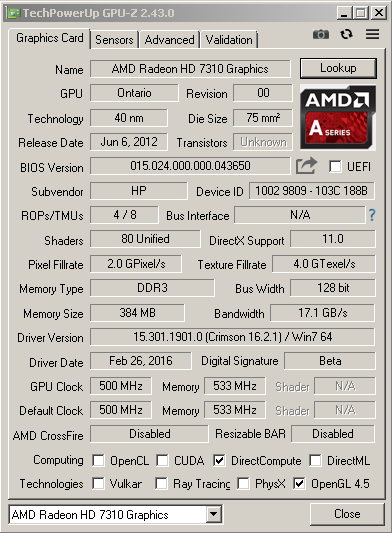Comparing: AMD Radeon HD 7310 vs Intel UHD Graphics 750
In this comparison, we analyze two Videocards: AMD Radeon HD 7310 and Intel UHD Graphics 750, using synthetic benchmark tests to evaluate their overall performance. This side-by-side comparison helps users understand which hardware delivers better value, speed, and efficiency based on standardized testing. Whether you're building a new system or upgrading an existing one, this benchmark-driven evaluation offers valuable insights to guide your decision.

Intel UHD Graphics 750
| Type: | Videocards |
|---|---|
| Brand: | Intel |
| Model: | UHD Graphics 750 |
Specification Comparison Table
This specification comparison presents technical details of several devices or components to help you understand the key differences between each option. Use this table as a reference to determine which device best suits your needs.
| Specification | AMD Radeon HD 7310 | Intel UHD Graphics 750 |
|---|---|---|
| Architecture | Terascale 2 | Rocket Lake |
| Codename | Ontario | Rocket Lake GT1 |
| Buswidth | - | SHARED |
| Clock | 500 MHz - - | 350 MHz - 1300 MHz |
| Memory Clock | 384 DDR3 (SHARED) | SHARED |
| Technology | 40 nm | 14 nm |
| Interface | IGP | IGP |
| Technology | 40 nm | 14 nm |
| Segment | Laptop | Desktop |
Submission Comparison Table
This submission comparison table displays the number and details of benchmark data submissions from various devices or components. This information helps you understand the performance based on the benchmarks that have been tested, as well as providing an overview of the consistency and popularity of the available benchmark results.
| No. | Benchmark Software | AMD Radeon HD 7310 | Intel UHD Graphics 750 |
|---|---|---|---|
| 1 | AIDA64 GPGPU Benchmark - Single Precision FLOPS |
64.88 GFLOPS |
663.5 GFLOPS |
Submission Comparison Chart
This chart visualizes the benchmark scores comparison between two hardware devices based on submitted data.
Media Gallery
A collection of photos of tested hardware. These images can help you identify the physical form, model, and variant of the hardware in question. These photos are from our own documentation, and if they are not available we may not be able to document them.
About Hardware AMD Radeon HD 7310
The AMD Radeon HD 7310 is an entry-level integrated graphics processor (IGP) that is part of the AMD E1-1200 APU, launched in 2012 for budget-oriented laptops. Based on the Terascale 2 architecture, the Radeon HD 7310 features 80 stream processors (shaders) and runs at a clock speed of up to 500 MHz. While modest in terms of raw power, this GPU was designed to handle essential computing needs with minimal power consumption, making it ideal for ultraportable laptops and low-cost netbooks of its era.
The Radeon HD 7310 supports DirectX 11 and UVD3 (Unified Video Decoder) for smooth HD video playback, making it fairly capable for multimedia tasks such as watching YouTube videos or playing DVDs. However, it does not have dedicated VRAM, relying instead on shared system memory, which means that its performance is significantly influenced by the RAM configuration single-channel DDR3 memory limits its potential, while a dual-channel setup can offer slightly better bandwidth for graphical tasks.
In terms of gaming, the HD 7310 is only suitable for very light or older games, and even then, users will need to lower the resolution and graphics settings to achieve playable frame rates. Titles like Plants vs. Zombies, Angry Birds, or older 2D games can run reasonably well, but 3D games or anything newer than 2012 will likely struggle. The GPU’s aging architecture also limits compatibility and performance in modern applications and web-based 3D content.
Despite its limitations, the Radeon HD 7310 can still serve a purpose in legacy laptops such as the HP 1000 1b05au, especially for users who need a machine for basic productivity tasks, internet browsing, and light media consumption on older operating systems like Windows 7 or Windows 8. For budget-conscious users who still own or restore older laptops, this GPU represents a practical, if dated, solution for everyday computing.
Hardware Detail:
Device: HP 1000 1b05au
CPU: AMD E1-1200
RAM: 4GB DDR3 Single Channel 2 DIMM
OS: Windows 7, Windows 8
Wednesday, 26 December 2012 14:27:36 | Update: 1 month ago
About Hardware Intel UHD Graphics 750
Intel UHD Graphics 750 is an integrated GPU used in the 11th generation Intel Core processors (Rocket Lake), including models such as the Core i5-11400 and Core i7-11700. It has 32 Execution Units (EUs) and runs at frequencies up to 1.3 GHz, offering competitive graphics performance in the iGPU (integrated GPU) class. Designed to handle daily graphics tasks, the UHD Graphics 750 is a significant upgrade from its predecessor, the UHD 630, especially in terms of media efficiency and modern codec support.
With support for DirectX 12, OpenGL 4.6, and Vulkan 1.2, the Intel UHD 750 can run multimedia applications, 2D graphics, and light games in a stable manner. Hardware acceleration features for HEVC (H.265), VP9, and AV1 codecs are also present, enabling high-resolution video playback (up to 4K) with lower power consumption. In addition, HDR support makes this GPU suitable for entertainment needs such as video streaming, light video editing, and high-quality visual displays on modern monitors.
This GPU is integrated in systems like the Dell OptiPlex 5090 that use an Intel Core i7-11700 processor, 32GB of RAM, and Windows 10 operating system. In this configuration, the UHD Graphics 750 is able to handle most everyday visual computing needs without the need for a discrete GPU. The graphics performance is sufficient enough to open multiple browser tabs with multimedia content, run productivity applications such as Microsoft Office, Zoom, and even some light e-sport games.
Hardware Detail:
Device: Dell OptiPlex 5090
CPU: i7-11700
RAM: 32GB
OS: Windows 10
Tuesday, 13 June 2023 12:07:50 | Update: 1 month ago




